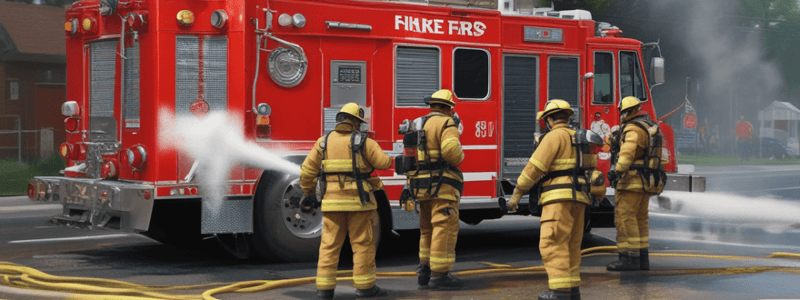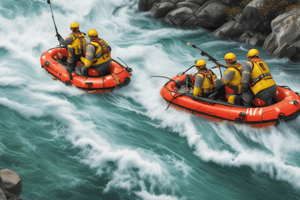Podcast
Questions and Answers
What action should the driver take once the engine at the water source has secured a water supply?
What action should the driver take once the engine at the water source has secured a water supply?
- Wait for the next engine to charge the supply line (correct)
- Charge the supply line before ensuring the next engine is ready
- Check the water supply before charging the supply line
- Monitor the water pressure after securing the supply
When should dual 4” lines be considered in a relay operation?
When should dual 4” lines be considered in a relay operation?
- If the length of the relay exceeds 2,000 feet and/or fire flow exceeds 1,000 GPM (correct)
- If the length of the relay is less than 1,000 feet
- When the required fire flow is below 500 GPM
- When tankers are not available for the operation
What is a key requirement for fill sites according to the policy?
What is a key requirement for fill sites according to the policy?
- Each fill site should be able to fill tankers at a rate of at least 1000 GPM (correct)
- The fill site engine must never be connected to a hydrant
- Fill sites should be made operational simultaneously
- Fill sites should not be named by their physical address
How should parking be managed during tanker operations?
How should parking be managed during tanker operations?
Why are cisterns with less than a 30,000 gallon capacity restricted from being used as the only fill site for a structure fire?
Why are cisterns with less than a 30,000 gallon capacity restricted from being used as the only fill site for a structure fire?
What should be avoided when designating fill sites according to the policy?
What should be avoided when designating fill sites according to the policy?
What is the purpose of assigning a Water Supply Officer (WSO) in rural water supply operations?
What is the purpose of assigning a Water Supply Officer (WSO) in rural water supply operations?
In rural water supply operations, what is the initial tactic referred to as?
In rural water supply operations, what is the initial tactic referred to as?
What is the expected fire flow limit in attack tanker operations?
What is the expected fire flow limit in attack tanker operations?
According to MCFRS policy, what are the criteria for choosing strategies and tactics for a fire incident?
According to MCFRS policy, what are the criteria for choosing strategies and tactics for a fire incident?
When should Class A foam solution be considered for the initial attack according to MCFRS policy?
When should Class A foam solution be considered for the initial attack according to MCFRS policy?
In urban water supply operations, what is a 'heavy water hook up'?
In urban water supply operations, what is a 'heavy water hook up'?
What is used in urban settings to identify the target hydrant according to MCFRS policy?
What is used in urban settings to identify the target hydrant according to MCFRS policy?
What is an essential consideration for laying dual four inch lines for master streams?
What is an essential consideration for laying dual four inch lines for master streams?
What is the primary role of the third due engine in urban water supply operations?
What is the primary role of the third due engine in urban water supply operations?
When should additional water supplies use a forward lay according to MCFRS policy?
When should additional water supplies use a forward lay according to MCFRS policy?
According to the policy, how many water supplies can be initiated for a single incident without the Incident Commander's permission?
According to the policy, how many water supplies can be initiated for a single incident without the Incident Commander's permission?
Which of the following is not a reason listed in the policy for the first due engine to elect not to lay a water supply line in a rural setting?
Which of the following is not a reason listed in the policy for the first due engine to elect not to lay a water supply line in a rural setting?
What is the order of preference for expanding water supplies in the rural environment according to the policy?
What is the order of preference for expanding water supplies in the rural environment according to the policy?
According to the policy, what is the first step in establishing a dump site operation?
According to the policy, what is the first step in establishing a dump site operation?
What is the primary responsibility of the Water Supply Officer (WSO) in the rural water supply operations described in the policy?
What is the primary responsibility of the Water Supply Officer (WSO) in the rural water supply operations described in the policy?
According to the policy, what is the main purpose of the attack tanker operation in rural water supply operations?
According to the policy, what is the main purpose of the attack tanker operation in rural water supply operations?
What is the main consideration for establishing a relay pumping operation according to the policy?
What is the main consideration for establishing a relay pumping operation according to the policy?
According to the policy, what is the first responsibility of the first due engine officer in rural water supply operations?
According to the policy, what is the first responsibility of the first due engine officer in rural water supply operations?
What is the preferred order for charging fire control systems according to the policy?
What is the preferred order for charging fire control systems according to the policy?
According to the policy, what is the responsibility of the second due engine if the first due engine does not initiate a water supply?
According to the policy, what is the responsibility of the second due engine if the first due engine does not initiate a water supply?
What is the primary purpose of the MCFRS Water Supply Appendix?
What is the primary purpose of the MCFRS Water Supply Appendix?
Which of the following is a key principle of the MCFRS approach to water supply for structural firefighting?
Which of the following is a key principle of the MCFRS approach to water supply for structural firefighting?
What is the relationship between water supply rate/reliability and tactical options according to the text?
What is the relationship between water supply rate/reliability and tactical options according to the text?
What is the significance of an engine arriving with only their tank water according to the text?
What is the significance of an engine arriving with only their tank water according to the text?
What are the two basic categories of water supply operations according to the text?
What are the two basic categories of water supply operations according to the text?
Which of the following statements about the MCFRS water supply model is true according to the text?
Which of the following statements about the MCFRS water supply model is true according to the text?
What is the primary mechanism by which Class A foam enhances fire suppression?
What is the primary mechanism by which Class A foam enhances fire suppression?
In the rural environment, why must personnel be exacting and judicious in their application of water?
In the rural environment, why must personnel be exacting and judicious in their application of water?
How many water supplies are established for each incident in urban areas, and why?
How many water supplies are established for each incident in urban areas, and why?
What is the role of the fifth due engine in water supply operations?
What is the role of the fifth due engine in water supply operations?
What is the critical flow rate, and how is it determined?
What is the critical flow rate, and how is it determined?
According to the policy, what is the primary tactic used by MCFRS for fire suppression in residential structures?
According to the policy, what is the primary tactic used by MCFRS for fire suppression in residential structures?
What is the purpose of establishing an independent water supply in the rear for urban incidents?
What is the purpose of establishing an independent water supply in the rear for urban incidents?
Which statement best describes the relationship between the critical flow rate and water supply reliability?
Which statement best describes the relationship between the critical flow rate and water supply reliability?
What is the potential consequence of flowing more than the critical flow rate during fire suppression operations?
What is the potential consequence of flowing more than the critical flow rate during fire suppression operations?
What is the purpose of using multiple smaller, more maneuverable lines instead of a single large, high flow line or master stream in certain situations?
What is the purpose of using multiple smaller, more maneuverable lines instead of a single large, high flow line or master stream in certain situations?
Flashcards are hidden until you start studying




